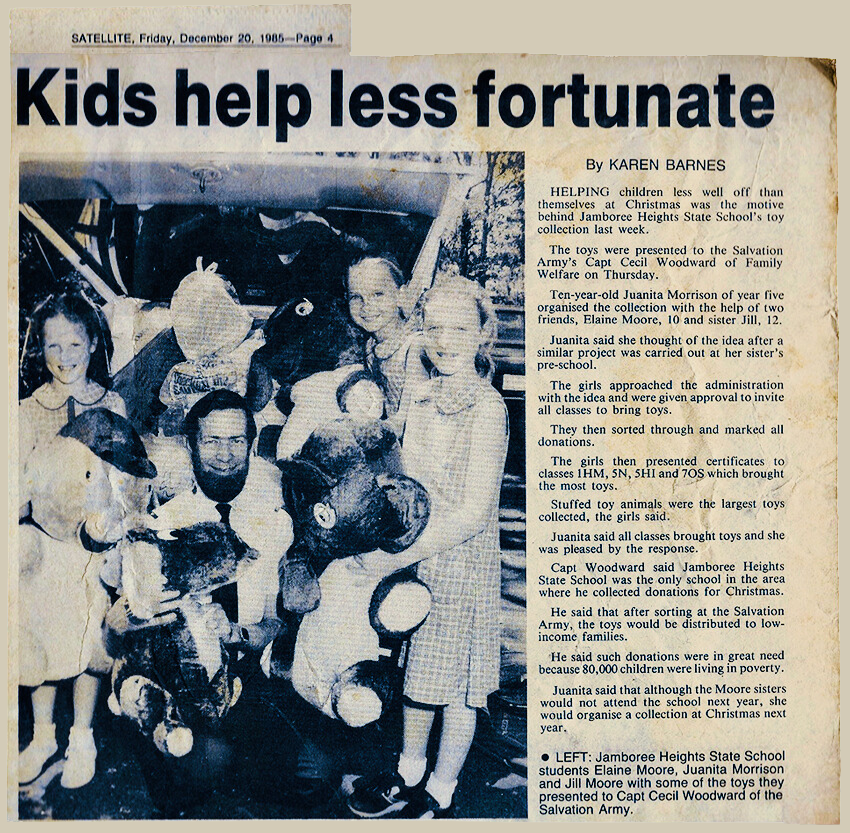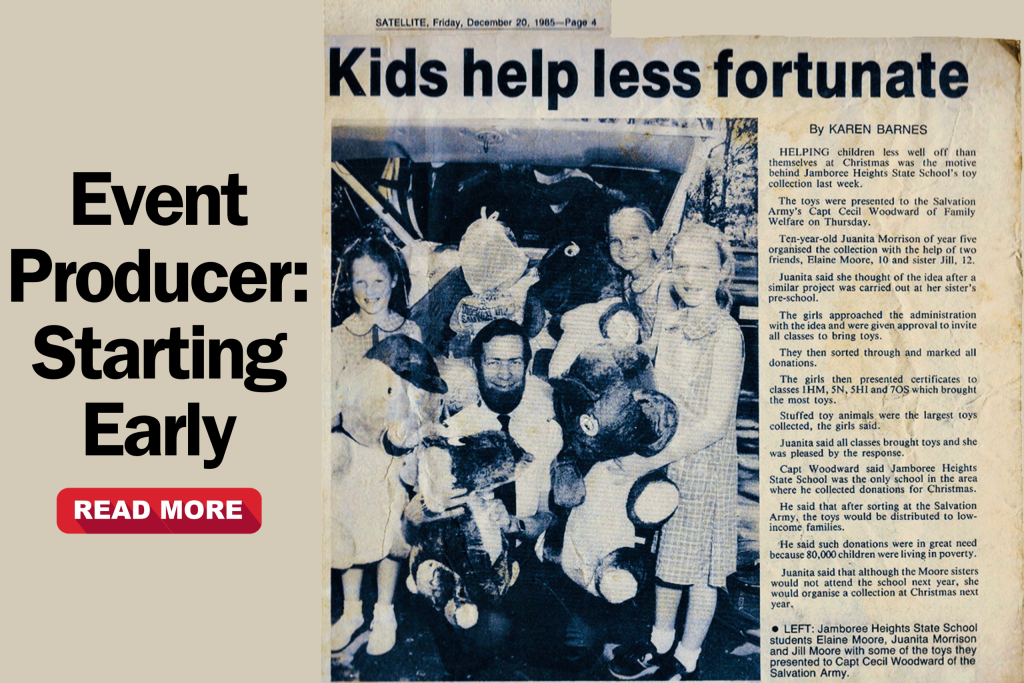On 20 December 1985, at the age of ten, I appeared in the local paper. I had organised a Christmas toy drive at my primary school with the help of two good friends.
It was my first (unpaid) role as an event producer.
The idea for the toy drive came to me after I had seen the local preschool attempting to run a toy drive to encourage families to donate toys they no longer need to give to families in need. I say attempting because even at age ten, my full & frank assessment was they were doing everything wrong.
The donations box was a small, tatty, cardboard box with a hastily handwritten ‘Donations’ sign written on a piece of spare paper tacked above it. It was located on the floor beside the door in the hallway as you entered the centre. It was ugly and uninviting. I only saw it because I was maybe pushing 125cm tall at the time (I was always in the lowest possible height percentile).
Unsurprisingly, the box was almost empty.
No doubt overly harshly (the people there all had day jobs as early childhood educators, and they were also trying to do good), I distinctly remember thinking of all the ways this was setting them up to fail. And with the audacious hubris that can only be mustered by a precocious ten-year-old, I resolved to do it better and, in the process – test my theories about running programs/events, strategy and persuasion – though the words I used at the time would have been more blunt and less business-centric.
I solicited help from a friend and her sister, whom I knew to be trustworthy. And if I have somehow omitted to praise and apologise to you, Elaine and Jill, for enduring 10-year-old producer Juanita, let me do it now. I have no doubt she could be insufferable when determined she knew best, but she could not have done it without you.
I then asked the Principal and Deputy Principal of the school to sign off on the endeavour. A key point of my proposal was my insistence that I run it rather than handing the idea over to the P&C. When he expressed his concerns this might be too much for a student (or even three students) to handle and that it might be best for the adults to take charge, I assured him that was not the case. I told him, in no uncertain terms, that I had seen how the adults handled it at the preschool, and while I didn’t think we should tell them because it would hurt their feelings, it was so bad it was embarrassing.
He asked if I had a plan.
Of course, I did. And I presented it to him and the Deputy Principal. To their great credit, they approved the student-run project.
My initial plan development started with formulating a solution for everything I had assessed that the preschool was doing wrong.
- There was only one sign: it wasn’t attention-grabbing or attractive, easily visible, and it was in a ‘race-out-the-door’ zone.
- The donation box was tiny and ugly and didn’t invite donations.
- No one was talking about it with the parents.
- The kids were not involved.
- There was no collective motivation to do it.
Whether from the handing down of entrepreneurial DNA or via sheer instinct (perhaps a little of both), I knew that creating competition would be critical. I received permission to speak at assemblies and presented the toy drive as a competition to see which class could be the most giving. Elaine & Jill came up with the simple but brilliant idea of awarding certificates to recognise their success – something that had never occurred to me, and the interclass rivalry to do good became palpable.
I did a tour of all the classes to launch the drive, explaining why it was important and how they could donate their toys. We produced brightly coloured signs (Elaine and Jill excelled at this) and encouraged teachers to create unique, high-visibility donation baskets in their rooms – which they did beautifully. And we visited every classroom, every day, to ensure the toy drive was front of mind, giving praise and encouragement for every donation, large or small, as we went.
After a week, the Principal gave us a room to work out of in the main administration building because the toys were streaming in and needed to be stored somewhere. Elaine and Jill had the clever idea to sort all the donated toys based on age and gender (please note we were kids, and it was back in 1985) and who the toys would be most appropriate for, which was greatly appreciated by Captain Cecil Woodward from the Salvation Army when he arrived to pick them up. It was the first time I understood the value of having intelligent and insightful team members who see things differently from yourself and how that can add to a project.
The admin staff were lovely and supportive and gave us extra poster boards, paints, glitter and art supplies to make more signs. Our admin room had become our base of operations, and for several weeks, this was where you would find us before school and during breaks.
I recall one moment, a week or two after the toys started flooding in, when Principal Heiniger passed outside our room in the main office. I was inside working on my latest speech update (including calculating totals for the standing competition tallies) before doing a reminder round to the classrooms during morning notices. He paused and asked if I needed some help from the teachers. I turned, clipboard in hand and politely but firmly (think Hermione Granger) replied – No, thank you. I have everything under control.
And we did.
The toy drive was a major success and went on to be even bigger the following year. For me, it was incredibly rewarding. It allowed me to put my ideas (which I would now call entrepreneurial but were almost certainly labelled precocious or bossy at the time) to the test.
It was also personally beneficial. It was an extremely challenging time in my home life, and it allowed me to focus on taking action to help other people with their problems when I was not in a position to help myself with my own.
But as I think back on that moment when I looked at the donation box at the preschool at age ten and thought – there’s a better way to do this, it comes as no surprise that my professional life has come to include curating and producing TEDx events, local and international conferences and summits (including events in Brazil in 2023 and Chile in 2024), as well as speechwriting, speaker coaching and keynote speaking.
So if you’re looking to create or host an event, and you want it to be highly successful (and nothing like a tatty cardboard box), drop me an email at [email protected]


